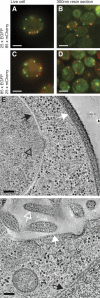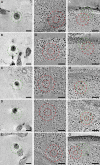Correlated fluorescence and 3D electron microscopy with high sensitivity and spatial precision
- PMID: 21200030
- PMCID: PMC3019550
- DOI: 10.1083/jcb.201009037
Correlated fluorescence and 3D electron microscopy with high sensitivity and spatial precision
Abstract
Correlative electron and fluorescence microscopy has the potential to elucidate the ultrastructural details of dynamic and rare cellular events, but has been limited by low precision and sensitivity. Here we present a method for direct mapping of signals originating from ∼20 fluorescent protein molecules to 3D electron tomograms with a precision of less than 100 nm. We demonstrate that this method can be used to identify individual HIV particles bound to mammalian cell surfaces. We also apply the method to image microtubule end structures bound to mal3p in fission yeast, and demonstrate that growing microtubule plus-ends are flared in vivo. We localize Rvs167 to endocytic sites in budding yeast, and show that scission takes place halfway through a 10-s time period during which amphiphysins are bound to the vesicle neck. This new technique opens the door for direct correlation of fluorescence and electron microscopy to visualize cellular processes at the ultrastructural scale.
Figures





References
MeSH terms
LinkOut - more resources
Full Text Sources
Other Literature Sources
Molecular Biology Databases

